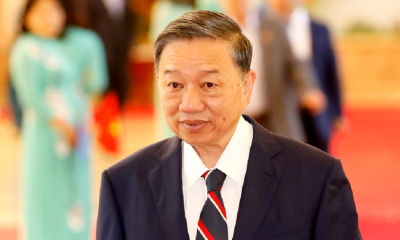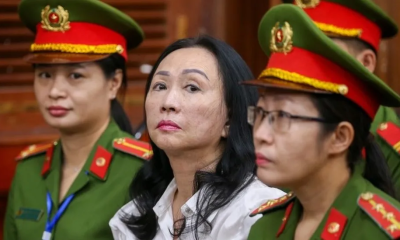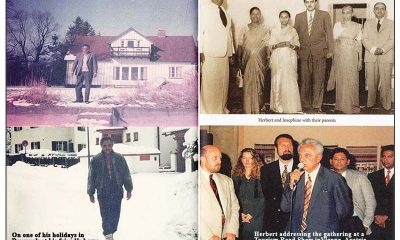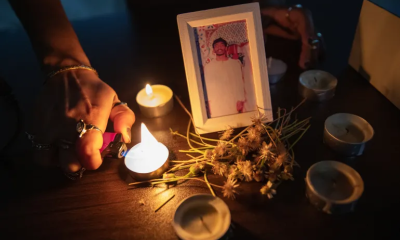Features
Terra cotta army in Xian and working in Vietnam
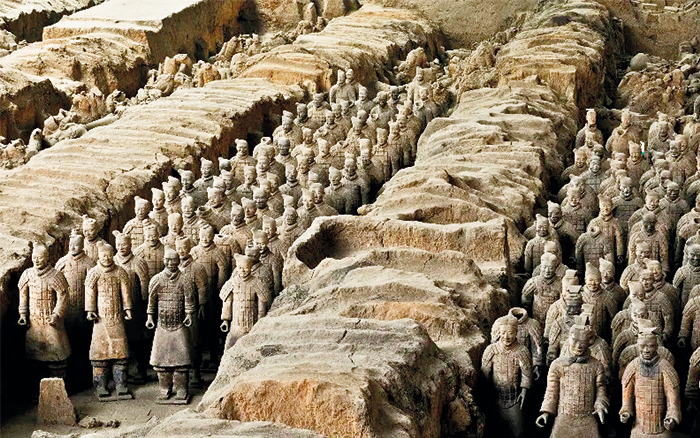
(Excerpted from Memories that Linger: My journey through the world of disability by Padmani Mendis)
I first heard of Xian when the famous Terra Cotta Army was discovered here in 1974. I was at Guys Hospital in London at the time, studying to be a teacher of physiotherapy. This was world news. Little did I think that I would one day actually see this spectacle. And here I was, taken on a tour of the site by an official from the Provincial Department of Civil Administration. He was born in this city. The people of Xian were proud of their cultural heritage. Our guide took his time explaining to Susan (my co-worker) and me the story of the discovery.
He said we were standing near the Mausoleum of the first Emperor of China by the name of Qin Shi Huang. The Emperor’s tomb has never been excavated. One day in 1974 while some farmers were digging a well near here, they found lots of pieces of pottery, including what appeared to be pieces of terracotta statues of soldiers and of horses and so on. The government took note of this and had Chinese archaeologists explore the site.
We were seeing what they found. Figures of a whole army that had been buried apparently surrounding the Emperor’s tomb as if to protect it. We gazed at the statues amazed. They were life-size, but heights varied. Each face was different with different features and expressions. They were dressed in different uniforms and had different hairstyles and head gear; this he said indicated their rank. Some were standing, others were kneeling with bows and arrows poised. And still others with bows and arrows by their side.
Only three of the pits on the site had been excavated. In the first pit there were more than 6,000 figures, and he said this was the main army. We paid more attention to the second pit. This had soldiers both as cavalry units with horses by their side and others as foot soldiers. We even saw chariots like those they would have gone to war with. And to think that these dated back to more than 200 years BC.
This was spectacular. But we found Xian itself a rather drab uninteresting city. Free market reforms had hardly touched it as yet. Tourism was yet to invade. Our hotel had seen better days. My husband visited here ten years later, and what he described to me was an amazingly different city.
Xian had been the capital of successive dynasties after its first Emperor Qin, and this was now showcased. Some of their mausoleums, tombs, old city walls and towers, ancient pagodas and other sites had been restored. It was now a “must visit” on any tourists’ itinerary or youngsters bucket list.
After Xian I stayed another three days in Beijing so I could experience some of its wonders. I chose not to join organised tours and went solo so I had time to drink it all in. It was relaxing spending time strolling along the Great Wall thinking of the many emperors who had a hand in the building of it from the time BC and the numerous wars it would been the focus of, the enemies it would have kept out and those that it did not.
Time was also spent at the Forbidden City, much more recent in comparison, built in the 15th century by the Ming Emperors. It remained as the residence of subsequent emperors and as the political centre of China until as recently as 1912. I had thought that the Forbidden City dated much further back. Two other sites I did not want to miss were the Ming Tombs and the Summer Palace. To visit both on one day I took an organised tour.
The Ming Tombs, although not as ancient as I had thought they were, was important not to miss out on simply for the fact that so many of the great emperors had been buried there. Only one of the 13 tombs had been excavated. We did not enter it. Instead, we walked around the parks and on part of what is called the Sacred Way. There were huge sculptures and lots of carved arches. Altogether very pleasant and relaxing. And it was good to know that we were at this historical place.
Our visit to the Summer Palace in a way was similar. We walked around a lot seeing the lakes and gardens landscaped in beautiful surroundings. The names of the three gardens in the complex were interesting – translated, they meant ‘perfect brightness’, ‘elegant spring’ and ‘eternal spring’. The Chinese have very meaningful names for everything.
I visited Beijing twice more to participate in meetings. On each occasion I spent time at the Great Wall and the Forbidden Palace. I did not go back to the Ming Tombs and the Summer Palace again.
Memories of Community Based Rehabilitation (CBR) that I have recalled until now I realise quite suddenly, come mostly from work which I have carried out for WHO. But there are other great CBR growers that I had the privilege of assisting in their goal of reaching disabled children and adults in the southern hemisphere. The first of these was Sweden. I have in Geneva recalled the Swedish International Development Agency, SIDA. Among others are Radda Barnen or RB later also known as Swedish Save the Children.
Then of course, in academia, that which had the earliest and greatest impact was ICH or the International Child Health Unit of Uppsala University. There was also the Norwegian Association of the Disabled more popularly called just NAD. Yes, the Scandinavians were into CBR in a big way. Then came the Japanese. This was through JICA or the Japan International Cooperation Agency. They were conscious of the situation of disabled people in our part of the world. And they were keen on playing a part in changing that situation.
Radda Barnen or RB, Sweden in Vietnam
Soon after Vietnam won their war against the USA, the country was in a desperate state with the loss of lives and physical destruction the Americans had left behind. Yet unknown were the long-term effects the Vietnamese would face from the chemical warfare used by the mighty enemy. I am sure the immediate effect of what the chemical warfare did was familiar all around the world.
Many images of a forlorn people on their barren land were featured in the World Press and on television. Images of massive environmental destruction are still vivid in my mind. Perhaps in yours too. And six decades later we still hear of infants being born with severe disease and disabilities. Because those chemicals still persist in Vietnam and continue on their seemingly unending path of destruction.
But one thing the Americans could not destroy was the Vietnamese spirit. Fighting a war using purely indigenous strategies and tools with no generous donors fattening their own arms industries by supplying weapons for mass-scale slaughter. Supplying these in their own interest. The war they were forced into brought the Vietnamese people together to fight together. And even when the Americans were long gone, the Vietnamese people stayed together to rebuild their lives, their communities, their country.
It was at this time that Radda Barnen, or RB, asked me whether I would go to Vietnam, VN for short, to help them start CBR. The incredible Olaf Palme, Sweden’s Prime Minister, had stepped in to help VN at a time when the rest of the world treated her as an outcast for her victory over the Americans.
The two countries had a bilateral agreement, with the former assisting in the development of VN’s Timber Industry and Health System, two of Sweden’s strengths. It was in this context that RB was in Hanoi with a programme directed at improving child health through Primary Health Care or PHC. VN had no other development partners at that time. The Dutch came in later, in a small way at first.
My Introduction to Vietnam
Radda Barnen, RB, had offered to include children with disabilities in their cooperation package. The health authorities wished to have an institution built for disabled children. RB talked to the authorities about the possibilities that CBR would offer. Their response was negative; the health people preferred the known, an institution.
Discussions went on for over a year before VN’s Health Ministry was persuaded that CBR may be a better option. Suited both to Primary Health Care and to their culture. In the context of the task that needed to be done of working closely with local people to introduce CBR to them, RB felt that it may be more prudent to send a fellow Asian to do the job with them rather than a Swede.
Having carried out a joint feasibility study, Dr. Anders Norman, who had spent many years for RB in VN, stopped over in Colombo on his way home to Stockholm from Hanoi to brief me about the task. When I greeted him at the Colombo airport, the look of surprise on his face was obvious.
Later, after we got to know each other I asked him about it. He said, “You know, in VN they believe that wisdom comes with age. And you looked so young. I wondered how they would respond to you. Now I know you, I have no concerns on that score.” I was in the fifth decade of my life.
And so it was that over the next 10 years and more I had the great good fortune to get to know these fascinating people, the Vietnamese, and their indomitable spirit. Together with that spirit and the war they fought, the Vietnamese had acquired exceptional organisational skills. They had systems in place to reach their people from the centre to the periphery. And this is what was surprising in a communist system, that at the same time they had systems from the periphery to the centre. I was of course most familiar with their health and their social welfare systems which grew from needs of their people at the grass roots.
Vietnam was a discard also because it had a communist government. Whatever ideology one may attach to the word “communism”, the system I found in VN was not the usual one that is associated with communist political systems. There was indeed a rigid hierarchical structure from the Central People’s Committee of the Communist Party in Hanoi, through those in the province and district to the Commune People’s Committees in every town and village.
These formed the government at each level and must conform to party principles and toe the party line. Deviation from this was not possible. But within the practice of those principles, I found that each People’s Committee was remarkably autonomous and could do their own thing for their members, VN’s citizens.
The beginning of CBR in Vietnam
Thus it was that CBR blended in smoothly within VN’s political administration and through that, its development. Within the People’s Committee at each level, one member was responsible for health and social welfare including employment. In the city of My Tho, Ba (meaning Mrs.) Nguyen was that member. She was my hostess in Tien Giang province and soon became my friend. She was the link between the Provincial People’s Committee and all the district committees with the Central Committee in Hanoi. She facilitated logistic support from Hanoi.
Each district made their own plans for CBR implementation, and within those plans so could reach peripheral People’s Committees. Health and Social Welfare Departments implemented those plans with the resources they commanded. And what is more, the Vietnamese people made this system work. They knew it was to their own benefit. This was obviously a remnant from having fought the war. It was by working together and for each other that they had overcome adversities.
In every community, many had been injured and left with impairment. Wherever possible, people had overcome the consequences of these and were active, contributing members of their communities. Take for example, the loss of limbs and other physical injuries, extremely common in VN because the war was fought on the ground, often face to face.
It was quite amazing for me to find so many amputees among the colleagues I worked with in government and among participants on my courses. So also, people who had parts of their bodies paralysed by poliomyelitis. More often than not these disabilities were not ever seen or noticed. They were not an issue. Some had improvised appliances, others had learned to adapt to living without them and get on with whatever it was they had to do.
Vietnam had also a consciousness and sensitivity about disability. It started within the family and extended into their community. Every member had to contribute whatever they could, and so also members who had disability. This was important for their sense of self-worth on the one hand and for the growth and development of their family on the other. Now when CBR brought them access to technology which enabled those members with disabilities to function and participate more effectively, it was welcome.
The WHO Manual in Vietnamese was an essential tool which they could use themselves. They had but few rehabilitation professionals in the country. When disability was extreme, community members supported the family to provide the care that was called for. In the villages, disabled people were encouraged to come together to share common problems and discuss possible issues. The seeds of what would grow into Disabled People’s Organisations were planted.
And so, the Vietnamese authorities requested RB for increasing support year by year to reach more parts of their country with CBR. First in the south in Tieng Giang, located in the Mekong delta and not far from Ho Chi Minh City. Here they made Cai Lay district a model for learning and teaching.
Then to the central region, to the ancient city of Hue and to Da Nang which had been occupied by American forces for a short while. The authorities then said to Radda Barnen, “Can you help us with the North? We have nothing there.”
So that was how it came to pass that I was with them walking the villages of Hai Hung and in Vinh Phu, where often I was the first foreigner even older children had seen. Radda Barnen support for disabled people was holistic, so there was interaction with the health referral system and physiotherapy and the employment and education sectors as well in Hanoi and in the provinces. And always, always linking with Peoples Committees for socialisation and inclusion.
Mr. Binh
With my memories of Vietnam come always to mind one individual – Mr. Binh. The community workers wanted me to meet Mr. Binh on one of my follow-up visits to their village. Mr. Binh had had a stroke. Since then, he had been confined to bed all day and all night for nine long years. This is how the community workers found him some months before, inside his tiny, dark, single-roomed home.
His wife left by his bedside all that he would need for the day while she went out to work. She left at dawn and returned after dark. After they found him, the community workers brought a few of his neighbours to Mr. Binh. They talked about his situation and how together they could help Mr. Binh. The neighbours were willing to do what they could.
Together, the workers and the neighbours first put up two bars by Mr. Binh’s bed. They helped him to stand up for some time each day. Then to take a few steps. Gradually Mr. Binh very cautiously learned to walk. As he did so, the neighbours and the workers extended the length of the bars to the door and then beyond. The day Mr. Binh walked out that door was the first time in nine years that he had seen the sun shine. But when I spoke with him, Mr. Binh told me that the greatest benefit CBR had brought him was the friendship and interest of his neighbours. They would now pop in ever so often for a chat and to help when needed.
My experience in Vietnam brought home to me the wise words of the great Ho Chi Minh, philosopher, visionary, and poet, a strength and inspiration to the Vietnamese people and to many of us in the developing world:
“By its very nature a stone will not budge by itself.
But when many people join hands,
a stone, however big and heavy can be moved aside.”
Features
The heart-friendly health minister

by Dr Gotabhya Ranasinghe
Senior Consultant Cardiologist
National Hospital Sri Lanka
When we sought a meeting with Hon Dr. Ramesh Pathirana, Minister of Health, he graciously cleared his busy schedule to accommodate us. Renowned for his attentive listening and deep understanding, Minister Pathirana is dedicated to advancing the health sector. His openness and transparency exemplify the qualities of an exemplary politician and minister.
Dr. Palitha Mahipala, the current Health Secretary, demonstrates both commendable enthusiasm and unwavering support. This combination of attributes makes him a highly compatible colleague for the esteemed Minister of Health.
Our discussion centered on a project that has been in the works for the past 30 years, one that no other minister had managed to advance.
Minister Pathirana, however, recognized the project’s significance and its potential to revolutionize care for heart patients.
The project involves the construction of a state-of-the-art facility at the premises of the National Hospital Colombo. The project’s location within the premises of the National Hospital underscores its importance and relevance to the healthcare infrastructure of the nation.
This facility will include a cardiology building and a tertiary care center, equipped with the latest technology to handle and treat all types of heart-related conditions and surgeries.
Securing funding was a major milestone for this initiative. Minister Pathirana successfully obtained approval for a $40 billion loan from the Asian Development Bank. With the funding in place, the foundation stone is scheduled to be laid in September this year, and construction will begin in January 2025.
This project guarantees a consistent and uninterrupted supply of stents and related medications for heart patients. As a result, patients will have timely access to essential medical supplies during their treatment and recovery. By securing these critical resources, the project aims to enhance patient outcomes, minimize treatment delays, and maintain the highest standards of cardiac care.
Upon its fruition, this monumental building will serve as a beacon of hope and healing, symbolizing the unwavering dedication to improving patient outcomes and fostering a healthier society.We anticipate a future marked by significant progress and positive outcomes in Sri Lanka’s cardiovascular treatment landscape within the foreseeable timeframe.
Features
A LOVING TRIBUTE TO JESUIT FR. ALOYSIUS PIERIS ON HIS 90th BIRTHDAY

by Fr. Emmanuel Fernando, OMI
Jesuit Fr. Aloysius Pieris (affectionately called Fr. Aloy) celebrated his 90th birthday on April 9, 2024 and I, as the editor of our Oblate Journal, THE MISSIONARY OBLATE had gone to press by that time. Immediately I decided to publish an article, appreciating the untiring selfless services he continues to offer for inter-Faith dialogue, the renewal of the Catholic Church, his concern for the poor and the suffering Sri Lankan masses and to me, the present writer.
It was in 1988, when I was appointed Director of the Oblate Scholastics at Ampitiya by the then Oblate Provincial Fr. Anselm Silva, that I came to know Fr. Aloy more closely. Knowing well his expertise in matters spiritual, theological, Indological and pastoral, and with the collaborative spirit of my companion-formators, our Oblate Scholastics were sent to Tulana, the Research and Encounter Centre, Kelaniya, of which he is the Founder-Director, for ‘exposure-programmes’ on matters spiritual, biblical, theological and pastoral. Some of these dimensions according to my view and that of my companion-formators, were not available at the National Seminary, Ampitiya.
Ever since that time, our Oblate formators/ accompaniers at the Oblate Scholasticate, Ampitiya , have continued to send our Oblate Scholastics to Tulana Centre for deepening their insights and convictions regarding matters needed to serve the people in today’s context. Fr. Aloy also had tried very enthusiastically with the Oblate team headed by Frs. Oswald Firth and Clement Waidyasekara to begin a Theologate, directed by the Religious Congregations in Sri Lanka, for the contextual formation/ accompaniment of their members. It should very well be a desired goal of the Leaders / Provincials of the Religious Congregations.
Besides being a formator/accompanier at the Oblate Scholasticate, I was entrusted also with the task of editing and publishing our Oblate journal, ‘The Missionary Oblate’. To maintain the quality of the journal I continue to depend on Fr. Aloy for his thought-provoking and stimulating articles on Biblical Spirituality, Biblical Theology and Ecclesiology. I am very grateful to him for his generous assistance. Of late, his writings on renewal of the Church, initiated by Pope St. John XX111 and continued by Pope Francis through the Synodal path, published in our Oblate journal, enable our readers to focus their attention also on the needed renewal in the Catholic Church in Sri Lanka. Fr. Aloy appreciated very much the Synodal path adopted by the Jesuit Pope Francis for the renewal of the Church, rooted very much on prayerful discernment. In my Religious and presbyteral life, Fr.Aloy continues to be my spiritual animator / guide and ongoing formator / acccompanier.
Fr. Aloysius Pieris, BA Hons (Lond), LPh (SHC, India), STL (PFT, Naples), PhD (SLU/VC), ThD (Tilburg), D.Ltt (KU), has been one of the eminent Asian theologians well recognized internationally and one who has lectured and held visiting chairs in many universities both in the West and in the East. Many members of Religious Congregations from Asian countries have benefited from his lectures and guidance in the East Asian Pastoral Institute (EAPI) in Manila, Philippines. He had been a Theologian consulted by the Federation of Asian Bishops’ Conferences for many years. During his professorship at the Gregorian University in Rome, he was called to be a member of a special group of advisers on other religions consulted by Pope Paul VI.
Fr. Aloy is the author of more than 30 books and well over 500 Research Papers. Some of his books and articles have been translated and published in several countries. Among those books, one can find the following: 1) The Genesis of an Asian Theology of Liberation (An Autobiographical Excursus on the Art of Theologising in Asia, 2) An Asian Theology of Liberation, 3) Providential Timeliness of Vatican 11 (a long-overdue halt to a scandalous millennium, 4) Give Vatican 11 a chance, 5) Leadership in the Church, 6) Relishing our faith in working for justice (Themes for study and discussion), 7) A Message meant mainly, not exclusively for Jesuits (Background information necessary for helping Francis renew the Church), 8) Lent in Lanka (Reflections and Resolutions, 9) Love meets wisdom (A Christian Experience of Buddhism, 10) Fire and Water 11) God’s Reign for God’s poor, 12) Our Unhiddden Agenda (How we Jesuits work, pray and form our men). He is also the Editor of two journals, Vagdevi, Journal of Religious Reflection and Dialogue, New Series.
Fr. Aloy has a BA in Pali and Sanskrit from the University of London and a Ph.D in Buddhist Philosophy from the University of Sri Lankan, Vidyodaya Campus. On Nov. 23, 2019, he was awarded the prestigious honorary Doctorate of Literature (D.Litt) by the Chancellor of the University of Kelaniya, the Most Venerable Welamitiyawe Dharmakirthi Sri Kusala Dhamma Thera.
Fr. Aloy continues to be a promoter of Gospel values and virtues. Justice as a constitutive dimension of love and social concern for the downtrodden masses are very much noted in his life and work. He had very much appreciated the commitment of the late Fr. Joseph (Joe) Fernando, the National Director of the Social and Economic Centre (SEDEC) for the poor.
In Sri Lanka, a few religious Congregations – the Good Shepherd Sisters, the Christian Brothers, the Marist Brothers and the Oblates – have invited him to animate their members especially during their Provincial Congresses, Chapters and International Conferences. The mainline Christian Churches also have sought his advice and followed his seminars. I, for one, regret very much, that the Sri Lankan authorities of the Catholic Church –today’s Hierarchy—- have not sought Fr.
Aloy’s expertise for the renewal of the Catholic Church in Sri Lanka and thus have not benefited from the immense store of wisdom and insight that he can offer to our local Church while the Sri Lankan bishops who governed the Catholic church in the immediate aftermath of the Second Vatican Council (Edmund Fernando OMI, Anthony de Saram, Leo Nanayakkara OSB, Frank Marcus Fernando, Paul Perera,) visited him and consulted him on many matters. Among the Tamil Bishops, Bishop Rayappu Joseph was keeping close contact with him and Bishop J. Deogupillai hosted him and his team visiting him after the horrible Black July massacre of Tamils.
Features
A fairy tale, success or debacle

Sri Lanka-Singapore Free Trade Agreement
By Gomi Senadhira
senadhiragomi@gmail.com
“You might tell fairy tales, but the progress of a country cannot be achieved through such narratives. A country cannot be developed by making false promises. The country moved backward because of the electoral promises made by political parties throughout time. We have witnessed that the ultimate result of this is the country becoming bankrupt. Unfortunately, many segments of the population have not come to realize this yet.” – President Ranil Wickremesinghe, 2024 Budget speech
Any Sri Lankan would agree with the above words of President Wickremesinghe on the false promises our politicians and officials make and the fairy tales they narrate which bankrupted this country. So, to understand this, let’s look at one such fairy tale with lots of false promises; Ranil Wickremesinghe’s greatest achievement in the area of international trade and investment promotion during the Yahapalana period, Sri Lanka-Singapore Free Trade Agreement (SLSFTA).
It is appropriate and timely to do it now as Finance Minister Wickremesinghe has just presented to parliament a bill on the National Policy on Economic Transformation which includes the establishment of an Office for International Trade and the Sri Lanka Institute of Economics and International Trade.
Was SLSFTA a “Cleverly negotiated Free Trade Agreement” as stated by the (former) Minister of Development Strategies and International Trade Malik Samarawickrama during the Parliamentary Debate on the SLSFTA in July 2018, or a colossal blunder covered up with lies, false promises, and fairy tales? After SLSFTA was signed there were a number of fairy tales published on this agreement by the Ministry of Development Strategies and International, Institute of Policy Studies, and others.
However, for this article, I would like to limit my comments to the speech by Minister Samarawickrama during the Parliamentary Debate, and the two most important areas in the agreement which were covered up with lies, fairy tales, and false promises, namely: revenue loss for Sri Lanka and Investment from Singapore. On the other important area, “Waste products dumping” I do not want to comment here as I have written extensively on the issue.
1. The revenue loss
During the Parliamentary Debate in July 2018, Minister Samarawickrama stated “…. let me reiterate that this FTA with Singapore has been very cleverly negotiated by us…. The liberalisation programme under this FTA has been carefully designed to have the least impact on domestic industry and revenue collection. We have included all revenue sensitive items in the negative list of items which will not be subject to removal of tariff. Therefore, 97.8% revenue from Customs duty is protected. Our tariff liberalisation will take place over a period of 12-15 years! In fact, the revenue earned through tariffs on goods imported from Singapore last year was Rs. 35 billion.
The revenue loss for over the next 15 years due to the FTA is only Rs. 733 million– which when annualised, on average, is just Rs. 51 million. That is just 0.14% per year! So anyone who claims the Singapore FTA causes revenue loss to the Government cannot do basic arithmetic! Mr. Speaker, in conclusion, I call on my fellow members of this House – don’t mislead the public with baseless criticism that is not grounded in facts. Don’t look at petty politics and use these issues for your own political survival.”
I was surprised to read the minister’s speech because an article published in January 2018 in “The Straits Times“, based on information released by the Singaporean Negotiators stated, “…. With the FTA, tariff savings for Singapore exports are estimated to hit $10 million annually“.
As the annual tariff savings (that is the revenue loss for Sri Lanka) calculated by the Singaporean Negotiators, Singaporean $ 10 million (Sri Lankan rupees 1,200 million in 2018) was way above the rupees’ 733 million revenue loss for 15 years estimated by the Sri Lankan negotiators, it was clear to any observer that one of the parties to the agreement had not done the basic arithmetic!
Six years later, according to a report published by “The Morning” newspaper, speaking at the Committee on Public Finance (COPF) on 7th May 2024, Mr Samarawickrama’s chief trade negotiator K.J. Weerasinghehad had admitted “…. that forecasted revenue loss for the Government of Sri Lanka through the Singapore FTA is Rs. 450 million in 2023 and Rs. 1.3 billion in 2024.”
If these numbers are correct, as tariff liberalisation under the SLSFTA has just started, we will pass Rs 2 billion very soon. Then, the question is how Sri Lanka’s trade negotiators made such a colossal blunder. Didn’t they do their basic arithmetic? If they didn’t know how to do basic arithmetic they should have at least done their basic readings. For example, the headline of the article published in The Straits Times in January 2018 was “Singapore, Sri Lanka sign FTA, annual savings of $10m expected”.
Anyway, as Sri Lanka’s chief negotiator reiterated at the COPF meeting that “…. since 99% of the tariffs in Singapore have zero rates of duty, Sri Lanka has agreed on 80% tariff liberalisation over a period of 15 years while expecting Singapore investments to address the imbalance in trade,” let’s turn towards investment.
Investment from Singapore
In July 2018, speaking during the Parliamentary Debate on the FTA this is what Minister Malik Samarawickrama stated on investment from Singapore, “Already, thanks to this FTA, in just the past two-and-a-half months since the agreement came into effect we have received a proposal from Singapore for investment amounting to $ 14.8 billion in an oil refinery for export of petroleum products. In addition, we have proposals for a steel manufacturing plant for exports ($ 1 billion investment), flour milling plant ($ 50 million), sugar refinery ($ 200 million). This adds up to more than $ 16.05 billion in the pipeline on these projects alone.
And all of these projects will create thousands of more jobs for our people. In principle approval has already been granted by the BOI and the investors are awaiting the release of land the environmental approvals to commence the project.
I request the Opposition and those with vested interests to change their narrow-minded thinking and join us to develop our country. We must always look at what is best for the whole community, not just the few who may oppose. We owe it to our people to courageously take decisions that will change their lives for the better.”
According to the media report I quoted earlier, speaking at the Committee on Public Finance (COPF) Chief Negotiator Weerasinghe has admitted that Sri Lanka was not happy with overall Singapore investments that have come in the past few years in return for the trade liberalisation under the Singapore-Sri Lanka Free Trade Agreement. He has added that between 2021 and 2023 the total investment from Singapore had been around $162 million!
What happened to those projects worth $16 billion negotiated, thanks to the SLSFTA, in just the two-and-a-half months after the agreement came into effect and approved by the BOI? I do not know about the steel manufacturing plant for exports ($ 1 billion investment), flour milling plant ($ 50 million) and sugar refinery ($ 200 million).
However, story of the multibillion-dollar investment in the Petroleum Refinery unfolded in a manner that would qualify it as the best fairy tale with false promises presented by our politicians and the officials, prior to 2019 elections.
Though many Sri Lankans got to know, through the media which repeatedly highlighted a plethora of issues surrounding the project and the questionable credentials of the Singaporean investor, the construction work on the Mirrijiwela Oil Refinery along with the cement factory began on the24th of March 2019 with a bang and Minister Ranil Wickremesinghe and his ministers along with the foreign and local dignitaries laid the foundation stones.
That was few months before the 2019 Presidential elections. Inaugurating the construction work Prime Minister Ranil Wickremesinghe said the projects will create thousands of job opportunities in the area and surrounding districts.
The oil refinery, which was to be built over 200 acres of land, with the capacity to refine 200,000 barrels of crude oil per day, was to generate US$7 billion of exports and create 1,500 direct and 3,000 indirect jobs. The construction of the refinery was to be completed in 44 months. Four years later, in August 2023 the Cabinet of Ministers approved the proposal presented by President Ranil Wickremesinghe to cancel the agreement with the investors of the refinery as the project has not been implemented! Can they explain to the country how much money was wasted to produce that fairy tale?
It is obvious that the President, ministers, and officials had made huge blunders and had deliberately misled the public and the parliament on the revenue loss and potential investment from SLSFTA with fairy tales and false promises.
As the president himself said, a country cannot be developed by making false promises or with fairy tales and these false promises and fairy tales had bankrupted the country. “Unfortunately, many segments of the population have not come to realize this yet”.
(The writer, a specialist and an activist on trade and development issues . )


